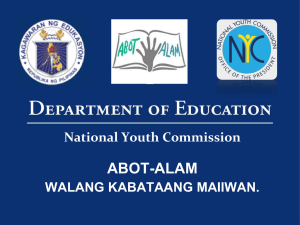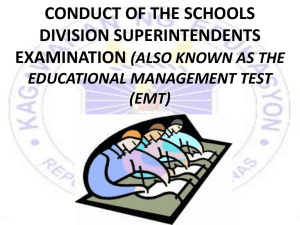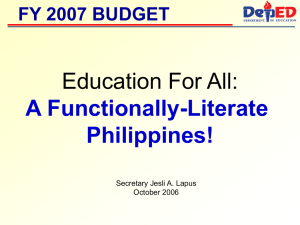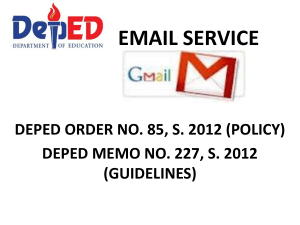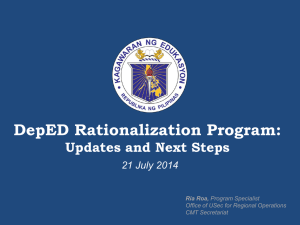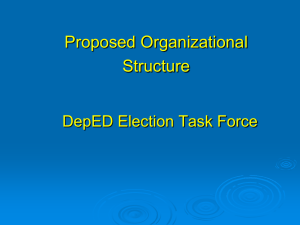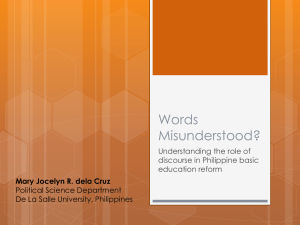Dr. Ruth L. Fuentes
advertisement
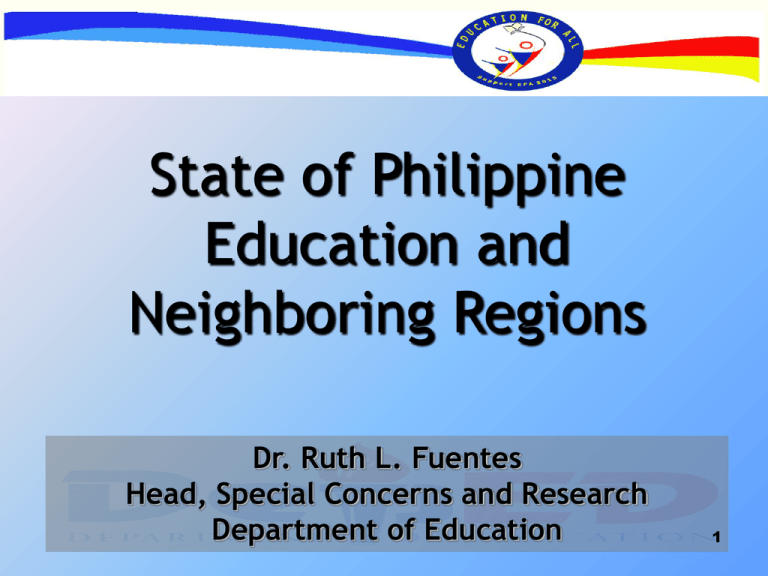
State of Philippine Education and Neighboring Regions Dr. Ruth L. Fuentes Head, Special Concerns and Research Department of Education 1 Presentation Outline I. The Philippine Education System • • • • • • II. III. IV. V. Department’s Mandate Vision, Mission and Core Values Structure of Philippine Education System Function Coverage The Education For All & Basic Education Sector Reform Agenda Basic Education Performance Budget and Financing Ten Point Education Agenda of the New Administration Legislative Agenda 2 1982 1987 1994 2001 Education Act of 1982 An Act providing for the establishment and maintenance of an integrated system of education. 1982 1987 1994 2001 1987 Philippine Constitution “The State shall protect and promote the right of all citizens to quality education at all levels and shall take appropriate steps to make such education accessible to all." (Art. XIV, Sec. 1) 1982 1987 1994 2001 Tri-focalization of Education Management DECS for basic education TESDA for post-secondary, middle-level manpower training and development (RA 7796, August 25, 1994) CHED for higher education (RA 7722, May 18, 1994) 1982 1987 1994 2001 “Governance of Basic Education Act of 2001” (R.A. 9155): Formally renamed DECS as the Department of Education and transferred “culture” and “sports” to the National Commission for the Culture and the Arts and the Philippine Sports Commission Redefined the roles of different administrative levels of DepED (central office, regional offices, division offices, district offices and schools) DepEd’s New Vision, Mission and Core Values Vision By 2030, DepEd is globally recognized for good governance and for developing functionally-literate and God-loving Filipinos. Mission To provide quality basic education that is accessible to all and lays the foundation of lifelong learning and service for the common good. Core Values Culture of Excellence, Integrity and Accountability; Maka-Diyos; Makatao; Makabayan; Makakalikasan Source: Adoption of the DepED-Balance Scorecard under the Performance Governance System per DepEd Order 39, s. 2010 Structure of Philippine Education System Age 3 4 5 Grade/ Year PRE – Level SCHOOL KINDER GARTEN 6 7 8 9 10 11 12 13 14 15 16 17 18 19 1 2 3 4 5 6 I II III IV ELEMENTARY SECONDARY (Compulsory) (Optional) TERTIARY 20, 21 AND ABOVE GRADUATE Master Courses POST GRADUATE Doctoral Courses ALTERNATIVE LEARNING SYSTEM AGE LEVEL 15-24 – Out of School Youth Basic Literacy Level 25 above-Adults Elementary Level Secondary Level 8 Roles of DepED per RA 9155 Central Office OPERATIONS Region Division Schools > > > > > Policy-making Standards-setting Resource generation /Allocation Enforcement of standards Monitoring and quality assurance > Instructional leadership > Administrative support to schools (i.e. MOOE) > Resource generation (i.e. Local School Board) > Direct delivery of quality education 9 =1 Central Office Coverage = 16 + 1 ARMM Regional Office Schools Division Offices = 199** No. of Districts = 2,437 68% Public Elem. Schools* = 37,801 13% Private Elem. Schools = 7,084 10% Public High Schools* = 5,747 9% Private High Schools = 4,707 = *No. of schools includes data of SUCs, CHED and TESDA (as of Sept 22, 2009) **Including 5 interim divisions (as of July 6, 2010) 55,339 Schools 10 ATTACHED AGENCIES 1. PHILIPPINE HIGH SCHOOL FOR THE ARTS 2. NATIONAL BOOK DEVELOPMENT BOARD 3. NATIONAL COUNCIL FOR CHILDREN’S TELEVISION 4. NATIONAL MUSEUM 11 Coverage: Size of Learners (in ’000) 25,000 L E A R N E R S 20,000 15,000 10,000 5,000 0 Publ Priv SY 20012002 ALS3/ Secondary * Targets Priv SY 20052006 Publi c Privat e SY 20082009 Publ Priv SY 20092010 Publ Priv SY 20102011* 38 26 57 49 192 127 209 124 205 187 4,449 1,281 4,978 1,285 5,379 1,342 5,417 1,407 5,600 1,450 * Elementary 11,929 933 Preschool 322 Total Publ 350 19.33M 11,984 1,016 12,562 1,112 12,790 1,131 13,608 1,171 524 388 20.28M 746 429 21.89M 1,049 436 22.56M 1,877 453 24.55M 12 The EFA and BESRA Philippine Education For All (EFA) 2015 Plan Basic Education Sector Reform Agenda (BESRA) Functional Literate Filipinos* * Ability to communicate effectively, solve problem, think critically and creatively, use resources 13 sustainably and be productive, develop sense of community and expand world view Basic Education Performance 14 INDICATOR A. ACCESS Indicators: 1. Gross Enrolment Rate Public and Private Public Only 2. Participation Rate Public and Private Public Only ELEMENTARY SECONDARY SY 2008-2009 SY 2009-2010 SY 2008-2009 SY 2009-2010 102.05% 91.13% 85.12% 75.55% 92.80% 82.92% 64.16% 67.91% 76.87% 60.74% 45.59% 48.65% 15 INDICATOR B. EFFICIENCY Indicators: 1. Completion Rate Public and Private Public Only 2. Drop-out Rate Public and Private Public Only ELEMENTARY SECONDARY SY 2008-2009 SY 2009-2010 SY 2008-2009 SY 2009-2010 73.28% 63.34% 6.02% 8.85% 63.47% 75.24% 57.65% 58.05% 8.84% 7.45% 14.62% 14.70% 16 INDICATOR ELEMENTARY SECONDARY SY 2008-2009 SY 2009-2010 SY 2008-2009 SY 2009-2010 C. QUALITY Indicators: 1. National Achievement Test in MPS Public and Private 65.55% 68.01% 46.71% 45.56% Public Only 66.33% 69.21% 47.40% 46.38% Private Only 52.47% 44.17% 42.59% 2. School Readiness Assessment Results, % of Gr.1 Assessed (Public) Pre-Assessment Ready 36.00% 40.00% Not Ready 64.00% 60.00% Post-Assessment Ready 69.00% 81.00% Not Ready 31.00% 19.00% 3. Accreditation and Equivalency ALTERNATIVE LEARNING SYSTEM Results FY 2008 FY 2009 No. of Learners 319,200 332,500 No. of Test Takers 210,726 120,741 No. of Test Passers 54,219 25,487 % Test Passers based on Takers 26% 21% Growth rate used in school age population for 2008-2009 is 2.04% (constant) based on 2000 CPH17 Growth rate used in school age popualtion for 2009-2010 is based on regional growth rates based on 2007 Budget and Financing 18 DepEd Budget 250 200 150 Ave. Share of DepEd’s Budget from GDP: 2.26% 100 50 0 Budget % share of DepEd Budget to GDP P0.78B* P0.35B* P0.271B* P0.166B* P0.169B* P2.4B* P6.4B* P8.9B* P0.8B* 2001 2002 2003 2004 2005 90 2.5% 105 106 2.8% 2.5% 110 112 122 137 149 174 175 2.1% 2.0% 2.1% 2.0% 2.3% 2.3% 2006 2007 2008 2009 * Private sector support to basic education via Adopt a School Program on top of the GAA. 2010 2011* 202 19 DepEd Budget and % Share from the National Budget 200.00 16.00 14.00 150.00 12.00 10.00 100.00 8.00 6.00 50.00 4.00 2.00 - FY 2001 FY 2002 FY 2003 FY 2004 FY 2005 FY 2006 FY 2007 FY 2008 FY 2009 FY 2010 DepED Budget (P'B) 89.61 105.30 106.48 109.52 112.04 121.56 137.33 149.25 174.47 174.97 % share of National 13.77 13.49 13.24 13.62 12.35 12.74 12.19 12.16 12.33 11.35 20 0.00 FY 2010 DepED Budget, by Allotment Class (Share in %) Maintenance and Other Operating Expenses 13% Capital Outlay 7% Personal Services 80% 21 Official Development Assistance (ODA) 2% LGUs-Special Education Fund (SEF) 6% Others 5% SOURCE DepED Regular Budget DepED Regular Budget 87% Official Development Assistance (ODA) LGUs-Special Education Fund (SEF) Others Total AMOUNT FY 2009 (in Php M) 174,468 3,798 11,492 (as of 2008) 10,917 200,675 22 Ten Point Agenda of the New Aquino Administration 23 1. 12-Year Basic Education Cycle 2. Universal Pre-Schooling for all 3. Madaris Education as a Sub-system Within the Education 4. Technical-Vocational Education as an Alternative Stream in Senior High School 5. “Every Child A Reader” by Grade 1 24 6. Science and Math Proficiency 7. Assistance to Private Education as partners in basic education 8. Medium of Instruction rationalized 9. Quality Textbooks 10. Covenant with Local Governments to build more schools. 25 26 27 28 29 30 31 32 33 34 35 36 37 38 39 40 41 42 43 44 Thank you! 45 Briefer for the Committee on Basic Education and Culture, House of Representatives , August 11, 2010
